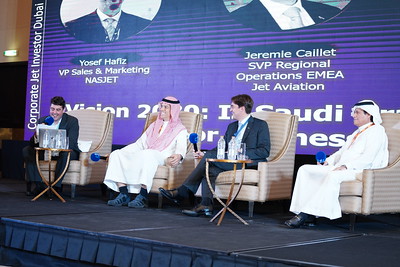New line in optimism – Middle East poised for boom

Much of the Middle East is booming. High energy prices and countries trying to get oil and gas from other countries are helping the region. The Economist estimates that Saudi Arabia, Qatar, the UAE, Bahrain, Kuwait and Oman will benefit from a “$3.5trn energy bonanza over the next five years”.
This was reflected in the audience at Corporate Jet Investor’s Dubai 2022 conference this week, where 55% were optimistic about their business in the next 12 months. The other 45% were very optimistic.
But Ali Ahmed Alnaqbi, founding and executive chairman at the Middle East and North African Business Aviation Association (MEBAA) started the conference with a warning.
“Business is going well but in reality, we are under attack,” he said. Alnaqbi highlighted the recent issues in France. And stressed that the industry needs to focus on sustainability and giving back with humanitarian flights. “We need to be leaders, not followers,” he stressed. Some 63% of delegates felt that the industry was under attack.
One country that is keen to grow its business aviation industry is the Kingdom of Saudi Arabia. Saudi Arabia’s Vision 2030 programme is best known for its planned megaprojects – which include the new economic area NEOM; ‘The Line’ a 170km-long straight-line city (part of NEOM); and the Red Sea Project which aims to unlock tourism.
“Not one person in Saudi Arabia has any doubt these projects will happen,” said Mohammed Bokhari, CEO of Aviation Horizons, a business jet and cargo operator.
Vision 2030 has three pillars: first, the country’s status as the heart of the Arab and Islamic worlds; second, making the country a global investment powerhouse; and third, making Saudi Arabia a global hub by connecting Africa, Asia and Europe.
Saudi Arabia’s General Authority of Civil Aviation (GACA) wants to grow business aviation to help make Vision 2030 a reality. The country is set to add four dedicated business aviation airports, 11 private jet terminals/FBOs and more than 400 helipads. (NEOM is being built with electric vertical aircraft in mind).
“Saudi Arabia is very much open for business aviation,” said Yosef Hafiz, vice-president sales and marketing at NASJET. “And there is going to be very strong growth with opportunities for both local and international companies.”
GACA is aiming to grow business jet flights from 17,000 to 93,000 per year by 2030. “We definitely see Saudi Arabia as one of the most exciting markets,” said Jeremie Caillet, senior vice president regional operations Europe, Middle East and Africa. Jet Aviation has operated in the country for more than 40 years.
Several Dubai operators were openly sceptical that the Kingdom will overtake the UAE as a business aviation hub. “It took years of work for Dubai to overtake Saudi Arabia as the centre of business aviation in 2016 and it is a mistake to underestimate all of this,” said one operator.
Dubai is also home to a significant number of Russian-owned business jets. With manufacturers no longer supporting them, many non-sanctioned Russian owners are now selling their aircraft. Several aircraft have now traded with dealers taking title. No one is interested in working with any individual or aircraft on a sanctions list.
Middle Eastern operators are still affected by supply issues – both lack of aircraft inventory and a shortage of parts for aircraft already delivered – but they have no doubt that demand should continue. Qatar and other airports in the region are also gearing up for the FIFA Football World Cup in eight weeks. You can see why people are feeling optimistic.
Subscribe to our free newsletter
For more opinions from Corporate Jet Investor, subscribe to our One Minute Week newsletter.








